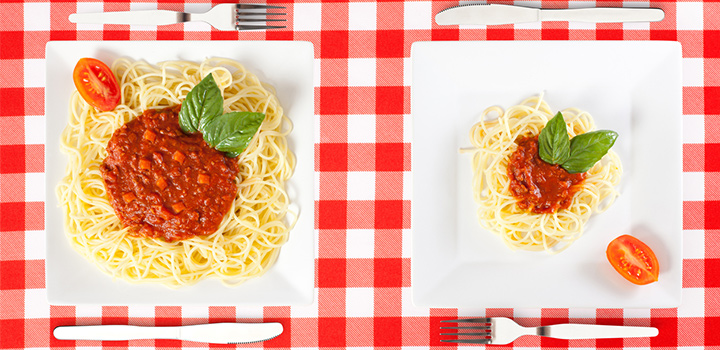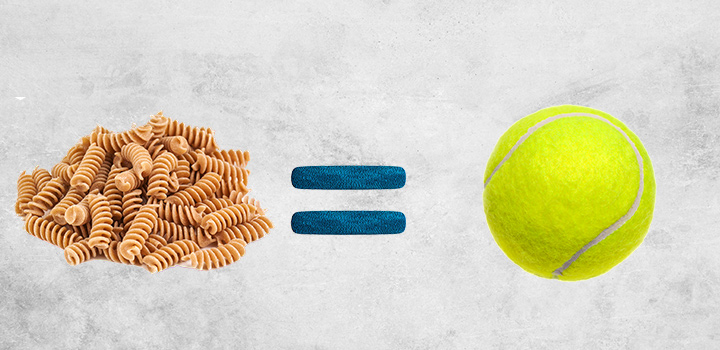Mind games: How your eyes can trick you into eating too much

Find yourself overeating? If you love food, but hate feeling bloated, lethargic or even unsatisfied after meals, you maybe be unknowingly consuming too much. Here's how the right visual cues can help you better manage your portions and become a more mindful eater.
How much of what you eat is just because that's what you have in front of you? To help answer this question, respected academics Brian Wansink, James Painter and Jill North Craft conducted a now-famous experiment called "bottomless bowls," which illustrated how visual cues can play an important role in preventing unintentional overeating. Here's what they learned.
Half of the research participants were served soup in a normal bowl, while the other half were served in a bowl that filled itself by means of a hidden mechanism. The refilling bowls gradually and indiscernibly filled up again as their contents were consumed. The researchers then gathered info on how much the participants thought they had eaten, how much they'd actually eaten, and how full they felt afterwards. The results are astonishing!
Participants ate 73% more, but didn't believe they were any fuller
In the researchers' words: "We found that the participants who were unknowingly eating from self–refilling bowls ate 73% more soup that those eating from normal bowls. However, [these] participants did not believe they consumed more, nor did they perceive themselves as more sated than those eating from normal bowls. This effect remained regardless of [their Body Mass Index]."
"When there was an accurate visual cue as to how much one had eaten, people stopped eating at an earlier point than when there was a biased visual cue of what they had eaten. Since people use their eyes to count calories and not their stomachs, the use of smaller bowls is an important tool for guiding consumption habits."
When bigger isn't better
This experiment shows that, no matter who you are, the amount of food you see in front of you influences how much you expect to eat, and how much you eventually eat. Bigger servings in bigger plates, bowls and glasses could have you eating and drinking much more than you should, and thinking nothing of it - in other words, mindless eating.
So it's not just important to divvy up your food into recommended portions, but also to teach yourself accurate visual cues. This way, even when you’re being served in dish sizes that are unfamiliar to you, like at a friend's house or at a restaurant, you can estimate when to stop.
How to practise portion caution
If you can't count on your usual plate to guide you, here are some visual cues for recommended portion sizes per meal. These general guidelines can help you decide when to stop eating (and pack or give away the rest):
What size should your food portion be?
Starchy foods, like brown rice and wholegrain pasta = tennis ball

Cheese = standard-sized matchbox

Protein, like meat, chicken, fish, legumes) = palm of your hand

Nuts or dried fruit = golf ball

Fruit = clenched fist
Remember that you should have at least five portions of fruit per day.

Vegetables = clenched fist
Remember that you should have at least five portions of vegetables per day.

"Remember, the total number of portions your body needs throughout the day is very personal - it depends on a number of factors, like your gender, metabolism rate and activity level. But everyone needs at least five portions of fruit and vegetables a day," says Terry Harris, a dietician at Discovery Vitality.
Mindful eating starts with being conscientious about what (and how much) you consume at every meal. To learn how many daily food portions you need, invest in your body's health by going to visit a dietitian, who will help you with an eating plan that suits your lifestyle and preferences.
Verve up your veggies
Plant-based foods are rich in minerals, fibre and phytonutrients. Embrace the abundance of the earth with the HealthyFood Studio Versatile Vegetables courses, and learn how to turn a variety of vegetables into much-loved meals.
Visit the HealthyFood Studio websiteGet rewarded for your healthy choices
In a rush and want to take the 'think work' out of shopping for lunch? Now you can, thanks to a brand new range of pre-packed lunchboxes from Woolworths.
The items in each lunchbox were carefully chosen by a Woolworths dietician to form a balanced meal, and are conveniently packed to offer you and your kids food on the go. Check out a handy no-stress lunchbox plan here.
Related articles
Why legumes deserve more of your love
When it comes to nutrition, legumes are the plant-world's dynamite in small packages. They may be little - but they're nutrient bombs! If you're unsure what legumes are or how to prepare them, learn all you need to know here.
10 ways to make water-drinking more frequent and fun
Do you struggle to drink as much water a day as you know you should? Here are some tips to help you hydrate more frequently - plus free recipes for water-rich treats!
10 ways to eat better every day
Finding it difficult to keep up a healthy diet? Try these 10 easy-to-remember hacks to help make healthy eating consistently achievable and fun!